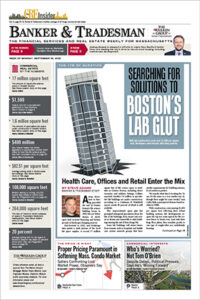Local lenders’ recent moves in and out of the indirect auto lending business provide a window into that market’s fluctuations on a broader scale.
The $1.9 billion Belmont Savings Bank, for instance, reported an $11.79 million decrease in indirect auto loans due to its suspension of new originations in that space. In its quarterly earnings statement, it cited “current market conditions” as the reason for doing so.
Brookline Bancorp, too, has been pulling back from indirect auto lending. In this most recent quarter, the bank’s holding company reported that its indirect auto loan portfolio had declined year-over-year to $11.2 million from $23.3 million in the same period last year as it wound down its portfolio and exited that space.
On the other hand, Berkshire Hills Bancorp is expanding into that space. Last summer, it tapped Ron A. MacDonald, a veteran in the indirect auto finance space, to head up its own indirect auto lending efforts.
“Banks have a tendency of getting in and out of this business, for what reasons I can’t speak to. If you want to grow your balance sheet fast from a loan standpoint, it could allow for that,” said Rich Porrello, the auto finance director at Huntington National Bank. “We stayed in the business in ’08, ’09, ’10 when others ran from it. We think part of the reason we’re in a growth mode is that dealers are very loyal to the lenders who stuck with them through the tough times.”
Indeed, the indirect auto loan business has been good to the Columbus, Ohio-based Huntington, which saw about 30 percent year-over-year production growth in its auto loan portfolio. Though Huntington’s branch footprint largely covers Ohio, Michigan and Indiana, the bank works with just over 3,900 dealers across 20 states and has a New England auto finance office in Westwood.
With around $9.9 billion in outstanding auto loans on its books, Huntington National Bank is the 18th largest lender in the retail auto loan market, capturing a little more than 1 percent of the total market nationwide, according to Experian Automotive.
Experian Automotive said earlier this year that automotive loan balances had increased 11.5 percent year-over-year to reach $987 billion nationwide, the highest level since Experian began publicly tracking that in 2006.
Experian doesn’t break that figure down by direct versus indirect loans, but it does break it down by market share distribution among lender types. At year-end 2015, banks held the largest share of auto loans nationwide with 35.8 percent of market share. Captive finance companies held 27.4 percent, credit unions 17.6 percent and finance companies 13.3 percent. Just a little more than 6 percent was captured by the “buy here, pay here” financing option.
While banks maintained the largest share of those loan balances at about $337 billion, it was finance companies and credit unions that saw the biggest year-over-year gains in that market, increasing their volumes 22.5 percent and 15.9 percent, respectively.
“It’s an intense market and very competitive, but that plays well for the consumer,” Porrello remarked.
Robert Ashbaugh, a senior risk management consultant at the firm Sageworks, said the moves in and out of the indirect auto space are largely strategic, but whether or not bankers will say as much, he thinks that one culprit stands out above the rest.
“Banks are in and out of indirect lending based on strategy and rates,” Ashbaugh said. “Recently some larger banks have pulled out of the space and cited a number of reasons – but one of the reasons, spoken or not, is the consumer regulations and the risk of being seen as discriminating against borrowers. There is competition in the space, meaning that rates will be lower and spreads thinner – hence the strategy reason to pull out.”
For whatever else may be going on in the indirect auto lending market right now, it’s hard to ignore regulation as a factor. The Consumer Financial Protection Bureau has taken up the mantle of regulating lenders in the indirect auto space ever since it slapped Ally Financial with an $18 million penalty and another $80 million in damages over discriminatory lending practices in 2013.
Porrello doesn’t seem particularly concerned about regulation, however.
“There’s been increased regulation in banking overall,” he pointed out. “That has caused certain lenders to exit the space, but for us, it’s about transparency to the consumer, and regulators do cause that in some cases. That’s been just fine.”
For those lenders that are committed to the space, regulation is just part of the cost of doing business.
“Really it is around strategy,” Ashbaugh said. “Given the risks, consumer compliance requirements and low spreads some banks just choose to ignore or will get out of the market. Some may jump back in.
Banks that are comfortable with the risk and the low spreads tend to look long term and see this as a business they want to be in.”








